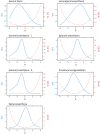Patient knowledge in anaesthesia: Psychometric development of the RAKQ-The Rotterdam anaesthesia Knowledge questionnaire
- PMID: 38995908
- PMCID: PMC11244777
- DOI: 10.1371/journal.pone.0299052
Patient knowledge in anaesthesia: Psychometric development of the RAKQ-The Rotterdam anaesthesia Knowledge questionnaire
Abstract
The transition from in-person to digital preoperative patient education requires effective methods for evaluating patients' understanding of the perioperative process, risks, and instructions to ensure informed consent. A knowledge questionnaire covering different anaesthesia techniques and instructions could fulfil this need. We constructed a set of items covering common anaesthesia techniques requiring informed consent and developed the Rotterdam Anaesthesia Knowledge Questionnaire (RAKQ) using a structured approach and Item Response Theory. A team of anaesthetists and educational experts developed the initial set of 60 multiple-choice items, ensuring content and face validity. Next, based on exploratory factor analysis, we identified seven domains: General Anaesthesia-I (regarding what to expect), General Anaesthesia-II (regarding the risks), Spinal Anaesthesia, Epidural Anaesthesia, Regional Anaesthesia, Procedural sedation and analgesia, and Generic Items. This itemset was filled out by 577 patients in the Erasmus MC, Rotterdam, and Albert Schweitzer Hospital, Dordrecht, the Netherlands. Based on factor loadings (≥0.25) and considering clinical relevance this initial item set was reduced to 50 items, distributed over the seven domains. Each domain was processed to produce a separate questionnaire. Through an iterative process of item selection to ensure that the questionnaires met the criteria for Item Response Theory modelling, 40 items remained in the definitive set of seven questionnaires. Finally, we developed an Item Response Theory model for each questionnaire and evaluated its reliability. 1-PL and 2-PL models were chosen based on best model fit. No item misfit (S-χ2, p<0.001 = misfit) was detected in the final models. The newly developed RAKQ allows practitioners to assess their patients' knowledge before consultation to better address knowledge gaps during consultation. Moreover, they can decide whether the level of knowledge is sufficient to obtain digital informed consent without face-to-face education. Researchers can use the RAKQ to compare new methods of patient education with traditional methods.
Copyright: © 2024 van den Heuvel et al. This is an open access article distributed under the terms of the Creative Commons Attribution License, which permits unrestricted use, distribution, and reproduction in any medium, provided the original author and source are credited.
Conflict of interest statement
I have read the journal’s policy and the authors of this manuscript have the following competing interests: JK was an unpaid medical adviser for NovaCair B.V., a developer of digital preoperative screening software. This does not alter our adherence to PLOS ONE policies on sharing data and materials.
Figures
References
-
- Kamdar NV, Huverserian A, Jalilian L, Thi W, Duval V, Beck L, et al.. Development, Implementation, and Evaluation of a Telemedicine Preoperative Evaluation Initiative at a Major Academic Medical Center. Anesthesia and Analgesia. 2020;131(6):1647–56. doi: 10.1213/ANE.0000000000005208 . - DOI - PMC - PubMed
-
- Kakinuma A, Nagatani H, Otake H, Mizuno J, Nakata Y. The effects of short interactive animation video information on preanesthetic anxiety, knowledge, and interview time: a randomized controlled trial. Anesth Analg. 2011;112(6):1314–8. Epub 2011/02/25. doi: 10.1213/ANE.0b013e31820f8c18 . - DOI - PubMed
MeSH terms
LinkOut - more resources
Full Text Sources
Medical
Miscellaneous




